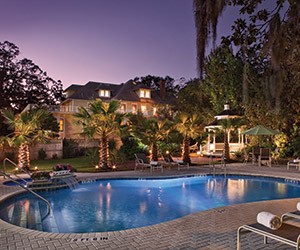Is Florida the land of the off-site venue? Could be, when you consider that so many attractions offer event space of one kind or another, from huge theme parks to city parks and sports parks, nature centers to a space center, and art museums to zoos.
Heritage homes in Florida are no exception. Put in historical context, these museum-worthy houses—and some are museums—tell the story of the state’s founding families and pioneers as well as the towns and cities they helped develop. But as settings for meetings and receptions, they’re hard to beat in terms of sheer elegance, architectural interest and their ability to transport guests back to another time and place.
“Once you’re on our property, it’s like you’re in a different world,” says Angie Vargas, sales coordinator for Orlando’s Courtyard at Lake Lucerne, which includes the Dr. Phillips House, named for a 19th century citrus pioneer and now operating as a B&B with a first floor featuring a meeting room and reception area hosting up to 60.
“When we rent meeting space, we generally give the group the entire first floor, so they have access to the different areas, including an outside veranda,” Vargas says. “We’re on several acres right in the middle of downtown.”
Heart-of-downtown locations are not surprising, considering that suburbia didn’t exist in Florida 100 years ago, and it only makes places like Bonnet House, Historic Needham Estate and Stranahan House, for example—all located in downtown Fort Lauderdale—that much more pedestrian-friendly and convenient to nearby attractions.
Historic homes in Florida welcoming group events also include the following options.
Burroughs Home and Gardens, Fort Myers
Built by businessman Nelson Burroughs in 1901 on the banks of the Caloosahatchee River in downtown Fort Myers, this Georgian Revival mansion was once the centerpiece of local society and boasted a guest list that included Thomas Edison and Henry Ford, who also lived and worked in the area.
“It’s the only home of its kind still standing in the city of Fort Myers that is open for tours. It’s quite something,” says Angela Melvin, executive director of the venue. “You can walk through the home and get a sense of what life must have looked like in 1901.”
Happily for groups, the entire home is open for exploration, upstairs and down, though Melvin says most gatherings take place behind the house in a new 300-person, climate-controlled pavilion set against the river.
“Many events start as a cocktail party in the house, then move outside,” she says. “We have an on-site caterer that operates from the old carriage house.”
The Addison, Boca Raton
Designed by architect Addison Mizner, who was responsible for many of Palm Beach County’s landmark buildings—including the Boca Raton Resort & Club—this 1920s estate is a standout with its cascading fountain, 100-year-old banyan trees and Old World architecture.
“People spend all day in a hotel at a meeting, and when they want something a little bit different and impressive, this is what they’re looking for,” says Jamie Salen, the venue’s corporate events manager. “We host a lot of client dinners, presentations and nonprofit fundraisers as well as VIP breakout meetings.”
PageBreak
Salen points to the venue’s versatility of spaces, including private rooms and a grand ballroom.
Another benefit of booking a place like The Addison is its built-in decor, Salen notes.
“You string lanterns in our courtyard, you get a flamenco guitarist, maybe some cigars, grab a fedora on the way in and you’re done,” she says, describing the popular “Havana Nights” theme. “Planners don’t have to go to the expense and trouble of decorating.”
Villa Woodbine, Miami
Built in 1931 by Walter De Garmo, reportedly the first registered architect in the Miami area and one of the designers of the nearby showpiece Villa Vizcaya, Villa Woodbine is set in Miami’s leafy Coconut Grove neighborhood and features De Garmo’s signature Mediterranean Revival style of courtyards, arches and loggias. Though a Spanish or Italian name might have been expected, the home’s original owner, Charles Boyd, founder of Wisconsin’s Appleton Paper Company, named his winter residence after a grade of paper called woodbine enamel.
The majority of the event space is outdoors, with a maximum capacity of about 230, says Sandra Perez, sales consultant at the venue.
Hoyt House, Fernandina Beach
Heading up Florida’s east coast to Amelia Island, the Victorian seaport village of Fernandina Beach covers the island’s northern end with magnificent structures that include the Hoyt House Inn, constructed in 1905 to resemble the Rockefeller Cottage on Jekyll Island and lived in by banker Fred W. Hoyt and his family until 1927.
Today, the 10-room inn features a swimming pool and hot tub, three public salons, a lounge complete with an English pub and Southern-style porch swings. When groups rent meeting space here, they rent the entire house, says co-owner Myrta Defendini.
“We’ve done lots of family reunions,” she says. “For meetings, our biggest space is the dining room, which can accommodate up to 20.”
Rutgers House, Tallahassee
Set in downtown Tallahassee and headquarters for the Tallahassee Garden Club since 1954, Rutgers House was built in 1848 for Henry Rutgers, a prominent local banker who served as Florida’s territorial treasurer and as a member of the Tallahassee City Council.
The home’s primary meeting space is a ballroom that holds about 100 and includes a stage and adjacent sunroom. An expansive lawn also hosts outdoor events and receptions.
“We’ve had as few as 20 meeting here and up to 150 if there’s more mingling than sitting,” says Sarah Kosturko, the Garden Club’s resident manager.






